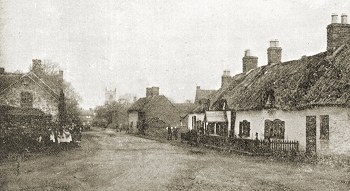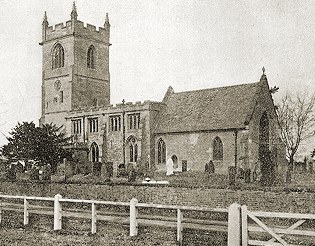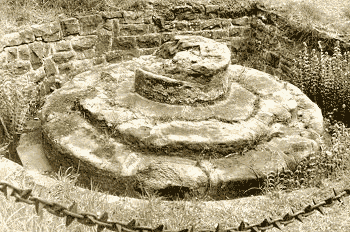|
Lower and Upper Penn are mentioned in the Domesday Book as
belonging to Godiva and her son Algar respectively.
Lady Godiva was one of the most
powerful women in England in the 11th century, but
surprisingly little is known about her. Although she is called
Godiva today, this is in fact the Latin form of the Anglo-Saxon
name Godgifu, meaning “Gift of God”. Her ancestry is uncertain1,
all that we can say is that she came from a wealthy background
and was born in the latter part of the 10th
century. Her brother was Thorold the Sheriff of Lincolnshire.
She was described as “the most beauteous of all women of her
time” by the chronicler Ingulphus.
Godiva owned land in Ansty, Atherstone, Coventry,
Gloucestershire, Hartshill, Kingsbury, Leicestershire, Meriden,
Nottinghamshire, Shropshire, Warwickshire and Staffordshire,
including 3 hides (360 acres) in Lower Penn. Her largest holding
was in Newark, Nottinghamshire. It is believed that she married
twice and was first widowed in about 1028, and suffered from
what was thought to be a life-threatening illness. During the
illness she bequested property to the church at Ely to ensure
her place in the after life. The close call with death left her
deeply religious with a great devotion the Virgin Mary.
In what is believed to be her second marriage, she married
one of the most powerful men in the country, Leofric, Earl of
Mercia and Lord of Coventry. He was born on 14th
May 968 as the third son of Leofwine, Aelderman of the Hwiccas2.
His two older brothers were killed in battle and so Leofric
succeeded his father in about 1024. In 1026 he described himself
as “Dux” which means a leader of an army. |
|

King's Bromley where Leofric died.
|
He became one of King Canute’s close and trusted
friends and was made Earl of Mercia, one of the three most
powerful men in the land.
Canute had two sons; Harold and Hardicanute. Leofric
assisted Harold to the throne in 1035 and helped Hardicanute to
suppress a revolt in Worcestershire. Most of Worcester was
burned to the ground and most of the inhabitants were killed. |
|
When Edward the Confessor came to power,
Godwin Earl of Wessex assembled an army against him in 1050.
Leofric and Siward, Earl of Northumbria defended the king
against the attack and Godwin fled into exile.
Leofric was described in the Anglo-Saxon
Chronicles as “wise for God and for the world”. Many thought of
him as saint, because along with King Edward he saw a vision of
Christ reflected in a mirror held by the chaplain in the Chapel
of Our Lady at Westminster.
Like Godiva, Leofric owned a lot of land.
Most of his estates were in Staffordshire, including: Alrewas,
Barton, Braunston, Bromley, Cannock, Chartley, Drayton, Elford,
Rolleston, Rugeley, Tutbury and Uttoxeter. He also owned land in
Warwickshire at Ansley, Ansty, Atherstone, Coventry, Foleshill,
Hartshill, Kingsbury and Meriden.
Godiva and Leofric were married sometime after 1028. They
owned Coventry and regularly visited there. In 1043 they founded
a Benedictine monastery on the site of St.Osburg's nunnery in
Coventry, which had been destroyed by the Danes in 1016. There
was an abbot and 24 monks on the site, which was dedicated to
the Virgin Mary, St. Peter, St. Osburg and All Saints, by Esdi,
Archbishop of Canterbury. During the dedication ceremony,
Leofric laid the dedication charter which granted the foundation
of the monastery on the alter. It also gave him lordship over 24
villages for the maintenance of the abbey. Godiva gave many
gifts in the honour of the Virgin Mary and is supposed to have
had her gold and silver melted down and made into crosses and
images of the saints to decorate the new building. The abbey was
destroyed during Henry VIII's dissolution of the monasteries and
the first Coventry Cathedral was built on the site. It was
assumed that all traces of the monastery had disappeared until
excavations in 1859 revealed the bases of 13th
century pillars, which are still visible today.
|
Godiva and
Leofric gave land to many churches on their estates, such as
those at Burton-upon-Trent, Coventry, Evesham,
Leominster, Much Wenlock and
St. Marystow in Lincolnshire. They founded churches in
many populated parts of their land and set up preaching crosses
in smaller settlements.
In 1912 the base of such a cross was discovered in St.
Bartholomew’s churchyard. It appears to be Saxon and has been
credited to Godiva. Visiting priests would have preached the
gospel here. It is the oldest known man-made structure in Penn. |

King's Bromley church.
|
|
This is what John of Worcester had to say
about Godiva and Leofric in his Chronicle:
Among his other good deeds in this life,
he and his wife, the noble countess Godgiva, who was a devout
worshipper of God, and one who loved the ever-virgin St. Mary,
entirely constructed at their own cost the monastery there
[Coventry], well endowed it with land, and enriched it with
ornaments to such an extent, that no monastery could be then
found in England possessing so much gold, silver, jewels, and
precious stones.
Godiva and Leofric had a son, Algar
(Elf-spear), who was appointed Earl of East Anglia by King
Edward in 1051, after Leofric had helped to suppress Earl
Godwin’s revolt. Algar owned a lot of land in Mercia including
Upper Penn. He became Earl of Mercia on his father’s death in
1057 and remained so until his own death in 1062. Algar was a
strong warrior and colourful character. He was outlawed by King
Edward in 1055 because he was considered to be
a traitor to the king and to all the people of the land. Before
the year was out he was forgiven and returned to his estates. He
was briefly banished a second time in 1058. On his death he was
buried at Coventry. Algar had two sons, Edwin and Morcar. Edwin
was murdered by his own troops on the sands of the Dee and
Morecar was involved in Hereward the Wake’s revolt
against the Norman invaders in 1070 to 1071.
|

| The base of the
Saxon Cross that was discovered at St. Bartholomew's
church beneath a sun dial. |
|
Godiva is remembered for the untrue legend of her
naked ride through Coventry. It was first recorded in Roger of
Wendover’s “Flores History” that was written in 1236, nearly two
hundred years after her death. None of the contemporary
chroniclers mentioned the event, which if true would certainly
have been recorded at the time.
Leofric died on 30th October 1057 and the
Anglo-Saxon Chronicle records that “He was very wise in all
matters, both religious and secular, that benefitted this
nation.” |
| He died on his estate at King's Bromley and was
buried in St. Mary’s monastery at Coventry.
After Leofric’s death Godiva moved to
Evesham and stayed at the monastery. She spent the rest of her
life there and witnessed the destruction of her estates. When
the Normans invaded, the Saxon landowners lost their possessions
to Norman dukes. Although Godiva lost most of her land, she was
still a wealthy lady with much land in Warwickshire after the
conquest. It is possibly the result of an alliance, made before
the conquest, between Duke William and Leofric or Godiva.
Godiva died on 10th September,
1067 at Evesham. She was buried in Evesham Abbey and tradition
has it that she was later re-interred in Coventry Abbey,
opposite Leofric. But there is no proof of this.
On her deathbed she ordered that her
gold-jewelled chain should be placed around the neck of the
image of the Virgin in Coventry Abbey. She stated that those who
came to pray should say a prayer for every stone in the chain.
References
1).
Angus Dunphy, Penn to Paper, 1996, p.17
2).
Robert K. Dent and Joseph Hill, Historic Staffordshire,
Midland Educational Company Ltd., 1896, p. 57
|

|
|

|
|

|
Return to
Anglo-
Saxon Mercia |
|
Return to
the
contents |
|
Proceed to
The Norman Conquest |
|